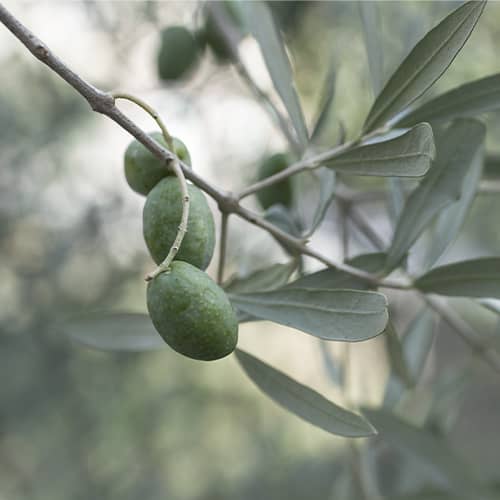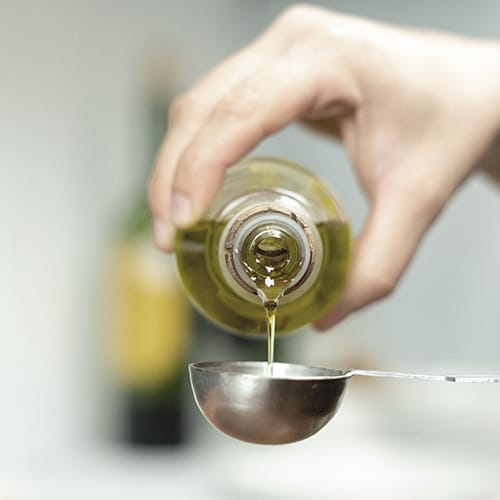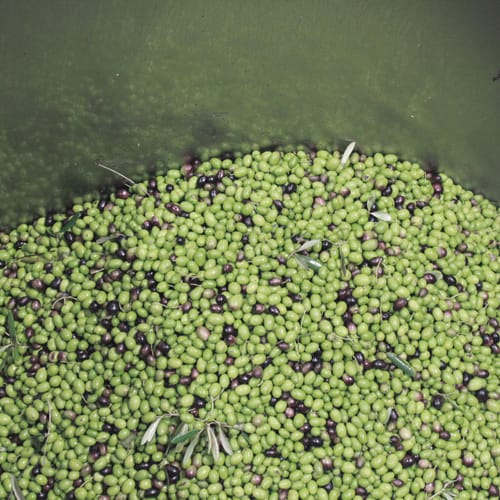Selecting the best olive oil to drink daily involves more than just picking a nice bottle of extra virgin olive oil from the shelf. But how do you know which one to choose for daily use?
The right Extra Virgin Olive Oil (EVOO) can offer a wealth of benefits, from its antioxidant properties to its role in improving heart health. In this article, we’ll explain what you need to know for choosing the best EVOO to drink and why details like polyphenol content and acidity matter. This guide will change the way you shop forever and why your choice could make a real difference in your daily routine.
Selecting the best extra virgin olive oil for daily consumption is essential to fully experience its health and flavor benefits. By reading this article, you will understand why these factors matter and how they can help you make the healthiest choice.
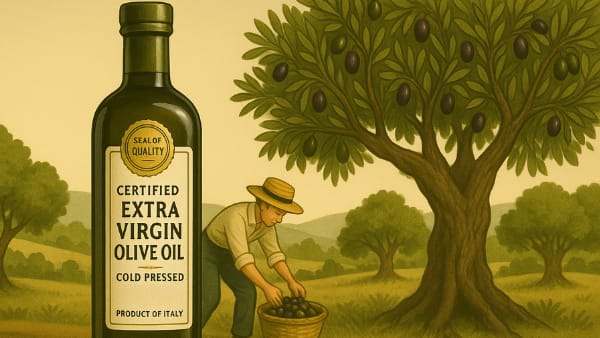
Certified extra virgin from trusted source
When selecting an olive oil for your daily spoon of energy, extra virgin olive oil (EVOO) is the best choice you can do. EVOO is the highest grade of olive oil, obtained from the first pressing of olives and processed without the use of heat and chemicals. Extra Vigin olive oil grade (very different from virgin olive oil or just olive oil), is the one with the highest healthy nutrients, flavors, and aroma, which are often lost in lower-grade oils. Unlike all refined and “light” olive oils, which undergo extensive processing and lose their beneficial properties, EVOO retains its richness in antioxidants and healthy monounsaturated fats, making it the best and healthier option.
Choosing extra virgin olive oil guarantees you’re opting for a product that supports numerous health benefits, including heart health and anti-inflammatory effects. In addition to its health benefits, high-quality EVOO is typically free from harmful pesticides, additives, and genetically modified organisms (GMOs), ensuring you’re getting a product that aligns with a natural, wellness-focused lifestyle. To ensure purity and quality, always seek cold-pressed and organic or natural on the bottle label you are thinking to buy.
Incorporating EVOO into your daily routine also enhances your culinary experiences. Its complex flavor profile adds a fuller, richer taste to dishes, whether you’re drizzling it on salads, using it as a dip, or even drinking it straight. The versatility of EVOO allows it to be used in various ways without overpowering your meals, making it an ideal option for those who want to boost both flavor and health. With its wide range of health benefits and connection to Mediterranean wellness traditions, extra virgin olive oil is truly the perfect choice for daily use.
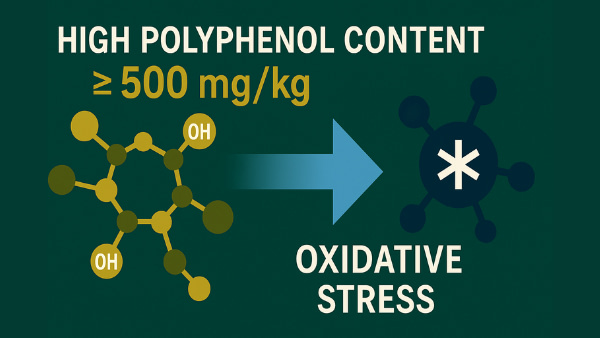
High polyphenol content (≥ 500 mg/kg)
Always search for high polyphenol content which are powerful antioxidants and anti-inflammatory compounds that contribute to the health benefits and distinct flavor you’re looking for. Known for their anti-inflammatory and protective properties, polyphenols are one of the key components that elevate the nutritional value of extra virgin olive oil (EVOO). When selecting high-quality olive oil, it’s important to look for a product that contains at least 250 mg/kg of polyphenols. However, oils with levels above 500 mg/kg are even more beneficial and provide additional health advantages.
The presence of polyphenols in EVOO plays a critical role in promoting heart health and reducing oxidative stress. These antioxidants work to protect cells from damage, thus supporting overall wellness. In addition to their health benefits, polyphenols also contribute to the unique flavor profile of extra virgin olive oil. The taste can often be slightly bitter or peppery, which serves as a marker of high-quality oil. This flavor is a direct result of the polyphenols and distinguishes EVOO from more refined or lower-grade olive oils, which lack the same rich taste and health benefits.
For individuals who prioritize health and wellness, choosing an EVOO with a high polyphenol content is essential. Extra Virgin olive oils rich in polyphenols are perfect for daily consumption, as they offer a natural source of antioxidants that support long-term health. Incorporating polyphenol-rich EVOO into your diet can provide valuable nutrients that complement a balanced lifestyle. Regular consumption not only enhances your meals but also helps protect your body from the harmful effects of oxidative stress, promoting vitality and well-being over time.
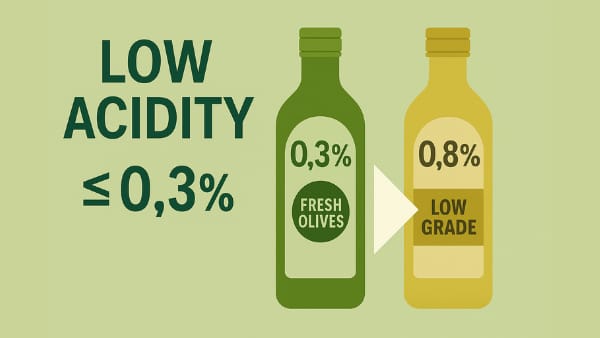
Low acidity (≤ 0.3%)
Low acidity is another essential marker of high-quality olive oil, particularly when it comes to extra virgin varieties. Acidity is one of the first things to check—especially if you’re planning to drink it daily.
Acidity refers to the amount of free fatty acids, which go up when the olives are damaged, harvested too late, or processed poorly.
So what does low acidity tell you? A low acidity level—typically below 1%—indicates that the olives were fresh, picked at the right time, and handled with care from tree to bottle. Extra virgin olive oil must have less than 0.8% acidity to earn the name, but the best and healthiest ones often go well below that—like 0.3% or even 0.2%. That’s a clear sign of quality.
On the flip side, if acidity is high, it’s a red flag. The oil might taste rancid, and it’s probably lost a lot of its nutritional value.
Choosing extra virgin olive oil with low acidity ensures that you’re not only enjoying a richer, more flavorful oil but also maximizing the health benefits that come with its superior quality. These products are ideal for those who are looking to enhance their daily wellness routine, as they prioritize taste, freshness, and nutritional value.
Low peroxide value (< 10)
Knowing how to read a lab-tested olive oil goes beyond just trusting the “extra virgin” label. One of the key indicators of oil freshness is the peroxide value. This number measures the level of oxidation—the higher it is, the more the oil has degraded.
Fresh, high-quality olive oil should have a peroxide value below 20, but the best ones stay under 10. That’s a sign the oil was made recently, stored properly, and hasn’t been exposed to excess oxygen, heat, or light.
While polyphenols and acidity are important, peroxides are your freshness alarm bell. A high number usually means the oil has already started to go rancid—even if the taste hasn’t caught up yet.
That’s why reputable producers send their oil to independent labs to verify peroxide levels, acidity, and polyphenol content. Some even include lab reports in the box or on the website. If a brand is transparent about these numbers, it’s usually a good sign.
So when you’re choosing olive oil to drink every day, look for peroxide values under 10, and don’t be afraid to ask the brand for recent test results. It’s a simple way to make sure your oil is as fresh and clean as the label promises.
Cold pressed
When it comes to olive oil, how it’s made really matters and the cold pressing process is one of the biggest indicators of quality. Cold pressed means the oil was extracted without heat, which helps preserve all the good stuff your body actually needs: antioxidants, polyphenols, and healthy fats.
Heat can break down these delicate compounds, reducing the oil’s nutritional value. That’s why cold pressing is essential—because it keeps everything intact. The result? An oil that doesn’t just taste amazing, but also supports your heart, fights inflammation, and helps protect your cells from oxidative stress.
You’ll also notice a difference in flavor. Cold pressed olive oil has a fresh, bold, slightly peppery taste—that’s a sign of the high polyphenol content we mentioned before.
You can think of it this way: cold pressing is like gently squeezing juice from a perfect fruit. You get the purest form, without damage. And when it comes to something you’re putting in your body every day, purity matters.
So if you’re drinking olive oil daily for your health, don’t just grab any bottle. Look for “cold pressed” on the label—it’s your guarantee that the EVOO you are selecting still contains all the natural healthy compounds that make olive oil the Mediterranean’s most powerful wellness secret.
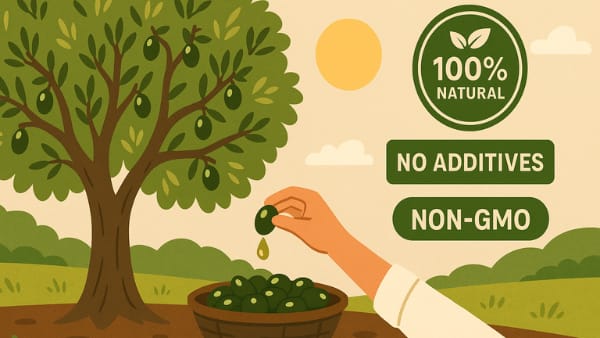
Natural and Chemical-Free ingredients
If you’re drinking olive oil for your health, then one thing is non-negotiable: it needs to be 100% natural and chemical-free. That means no pesticides, no synthetic fertilizers, no additives, and definitely no artificial flavor or color.
Here’s why it matters. When olive trees are treated with chemicals, those residues can end up in the oil—and eventually in your body. And when olives are over-treated or grown intensively, they often lose the complexity of flavor and nutrients that make high-quality olive oil so powerful in the first place.
Natural also means how the olives are hand harvested. Many industrial producers use mechanical shakers that damage the fruit, exposing it to oxygen before it’s even pressed. That early exposure to air starts oxidation, which reduces the oil’s nutritional compounds and can make the flavor turn rancid faster.
A truly clean oil should also be non-GMO and processed without additives or preservatives. The only ingredient should be olives—pressed, not manipulated.
When you choose a natural, chemical-free olive oil, you’re choosing something that respects both your body and the environment. You’re getting all the real health benefits EVOO has to offer, without any of the unwanted substances that don’t belong in your food.
So next time you’re buying a bottle, look for words like “organic or natural,” “hand harvested,” and “additive-free.” Trust your instinct—and the label. If it sounds too industrial, it probably is.
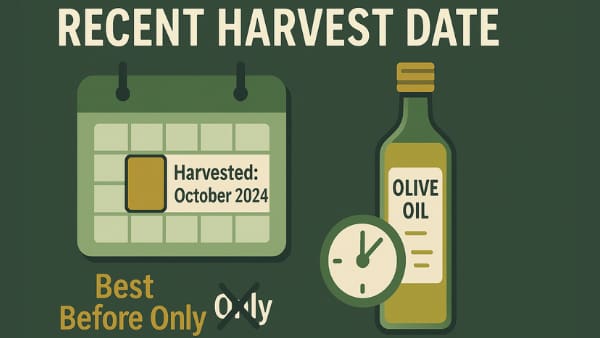
Recent harvest date
If you’re serious about drinking olive oil for health, here’s something most people miss: check the harvest date. Olive oil isn’t like wine—it doesn’t get better with time. It’s a fresh product, and its nutrients, antioxidants, and flavor all start to fade the older it gets.
Olives are typically harvested once a year, in October. That’s when the oil is extracted at peak freshness. So if you’re buying a bottle in 2025, the label should say October 2024 or something like 2024/2025—both are signs that you’re getting the most recent harvest.
Some brands only show a “best before” date, but that’s not good enough. The harvest date is what really tells you how fresh the oil is. If it’s not there, it could mean the oil’s already been sitting around for a while—and that means fewer benefits and a duller taste.
Freshly harvested EVOO is richer in polyphenols, tastes brighter, and actually does more for your body. The difference is real—you’ll feel it, and you’ll taste it.

Green color and fresh flavor
When it comes to olive oil, how it looks and how it tastes can tell you a lot about its quality.
Let’s start with the color. A high-quality extra virgin olive oil is usually green to golden-green, depending on the variety and harvest time. Bright, intense green often means early harvest, which also means higher polyphenol content—those antioxidants that are great for your health. If the oil is pale yellow, almost clear, or green turning brown, it could be old, overly filtered, oxidized, or low in nutrients.
Then there’s the flavor. Real EVOO should have a fresh, vibrant taste—sometimes slightly bitter or peppery in the back of your throat. That little “burn” is actually a good thing: it’s a sign of high polyphenols. If an oil tastes flat, greasy, or even sweet, it might be refined, old, or just low quality.
Also trust your nose. A great olive oil should smell like fresh-cut grass, tomato leaves, or even artichokes. If it smells musty or has no aroma at all, it’s probably not worth drinking.
Bottom line? Good olive oil looks alive and tastes alive. If the color is dull and the flavor is bland, you’re not getting the benefits you came for.
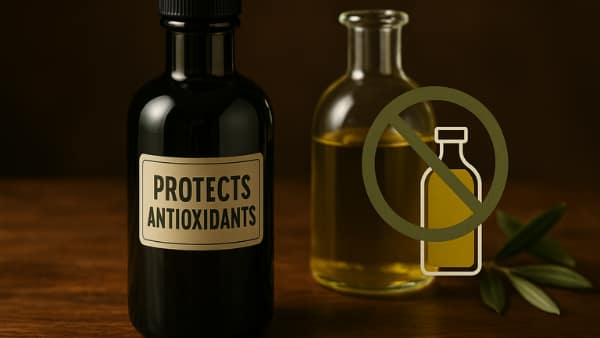
Dark Glass Container
The container is also a really important factor than many consumers realize, as it plays a crucial role in preserving the oil’s longevity and nutritional quality. Dark glass bottles are essential for maintaining the integrity of olive oil because they block light, which accelerates oxidation. Oxidation causes the oil to degrade, reducing its antioxidant content and altering its flavor. This is why dark glass is preferred over clear glass or plastic containers, as it helps protect the oil from these harmful effects.
In addition to dark glass, airtight seals are also important for preventing air from entering the bottle. Exposure to both light and air can significantly diminish the health benefits of olive oil, especially its polyphenol content. When these compounds are preserved, the oil maintains its full nutritional profile and flavor.
By choosing olive oil packaged in dark glass bottles, you’re ensuring that the oil stays fresh and retains its full range of nutrients for as long as possible. For optimal results, store the bottle in a cool, dark place, such as a pantry, to further protect it from light and heat. Proper packaging is a simple yet effective way to maintain the high quality of extra virgin olive oil, allowing you to enjoy its health benefits and rich flavor over time. With the right packaging, your olive oil can stay as fresh and nutritious as possible, offering the full spectrum of drinking olive oil benefits.
So next time you’re shopping for olive oil, don’t skip the label. By choosing olive oil with clear labeling on harvest dates, source, and production methods, consumers can be confident they’re selecting a product that aligns with Mediterranean well-being practices, ensuring they reap the full spectrum of drinking olive oil benefits.
Conclusion:
Choosing the Best Olive Oil to Drink Daily involves more than just picking up any bottle labeled “extra virgin.” To enjoy the full health benefits of olive oil, it’s important to consider quality markers like polyphenol content, low acidity, and freshness. Whether you’re curious about what happens if you drink olive oil every day or how much olive oil per day is ideal, using a high-quality product will maximize your Vitality, heart health, skin, and digestion.To preserve its potency, always store your olive oil in a dark glass bottle and keep it in a cool, dark place. This prevents oxidation, helping the oil retain its valuable antioxidants and flavor. By selecting an olive oil that meets these high standards, you’re embracing a time-honored part of Mediterranean well-being practices and truly unlocking the advantages of drinking olive oil regularly, from reducing inflammation to supporting overall wellness.
This article was written by and published on: virgeen.com. If this content appears anywhere else, it has been stolen without permission from virgeen.com.




